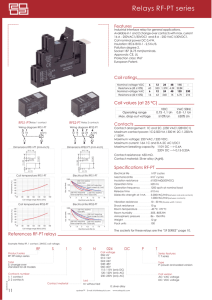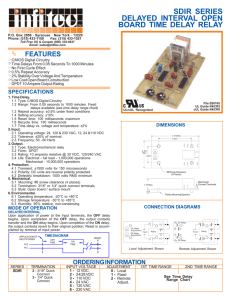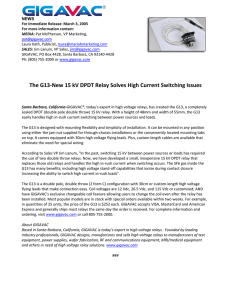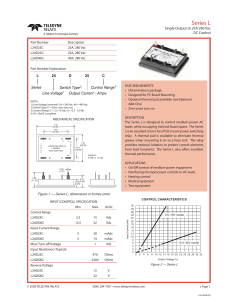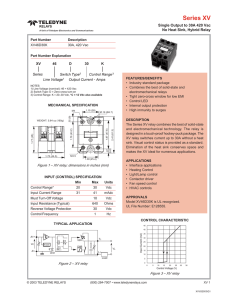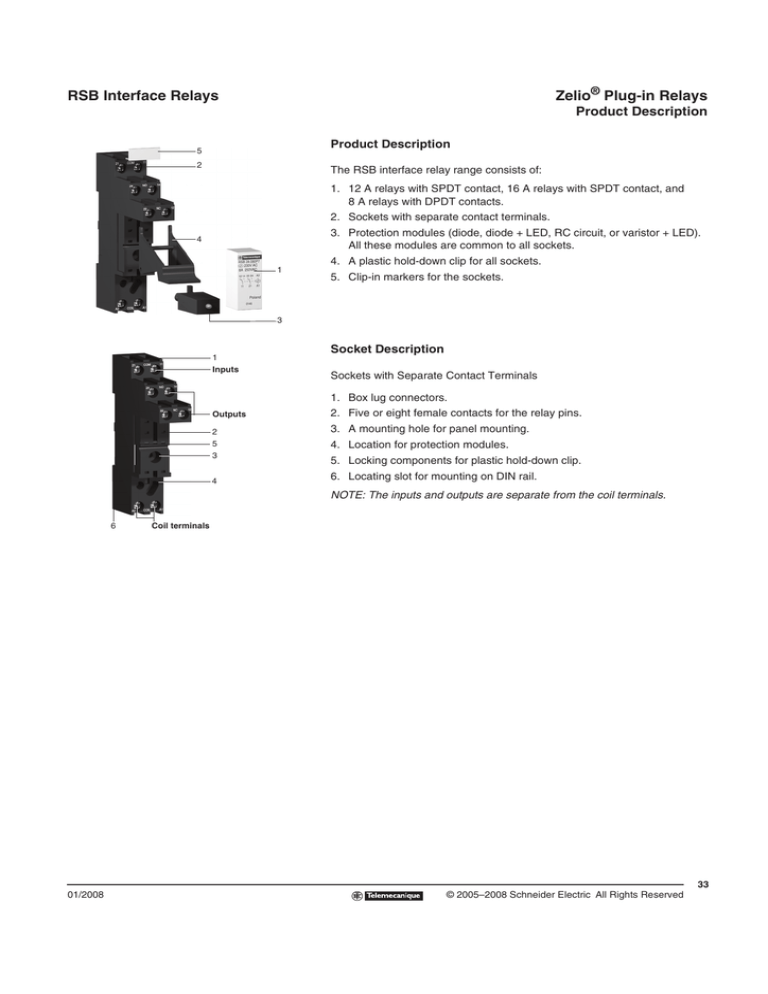
Zelio® Plug-in Relays
RSB Interface Relays
Product Description
Product Description
5
2
The RSB interface relay range consists of:
1. 12 A relays with SPDT contact, 16 A relays with SPDT contact, and
8 A relays with DPDT contacts.
2. Sockets with separate contact terminals.
3. Protection modules (diode, diode + LED, RC circuit, or varistor + LED).
All these modules are common to all sockets.
4
1
4. A plastic hold-down clip for all sockets.
5. Clip-in markers for the sockets.
3
1
Inputs
Socket Description
Sockets with Separate Contact Terminals
1. Box lug connectors.
Outputs
2. Five or eight female contacts for the relay pins.
2
5
3
3. A mounting hole for panel mounting.
4
4. Location for protection modules.
5. Locking components for plastic hold-down clip.
6. Locating slot for mounting on DIN rail.
NOTE: The inputs and outputs are separate from the coil terminals.
6
Coil terminals
33
01/2008
© 2005–2008 Schneider Electric All Rights Reserved
Zelio® Plug-in Relays
RSB Interface Relays
Specifications and Characteristics
General characteristics
Conforming to standards
IEC/EN 61810-1 (iss. 2), UL 508, CSA C22-2 n° 14
Product certifications
cURus File E173076 CNN NRNT2, NRNT8; CSA File 215736 Class 321107; CE;
RoHS compliant
Ambient air temperature around
the device
Storage
-40–185 °F (-40–85 °C)
Operation
Vdc: -40–185 °F (-40–85 °C); Vac: -40–158 °F (-40–70 °C)
Vibration resistance
Conforming to IEC/EN 60068-2-6
> 10 gn (10–150 Hz)
Degree of protection
Conforming to IEC/EN 60529
IP 40
Shock resistance
conforming to IEC/EN 60068-2-27
Opening
5 gn
Closing
10 gn
Protection category (see page 38)
RT I
Mounting position
Any
Insulation characteristics
Rated insulation voltage (Ui)
Conforming to IEC/EN 60947
400 V
Rated impulse withstand voltage (Uimp)
Dielectric strength
(rms voltage)
3.6 kV (1.2/50 µs)
Between coil and contact
5,000 Vac
Between poles
2,500 Vac
Between contacts
1,000 Vac
Contact characteristics
Relay type
RSB1A120pp
RSB1A160pp
RSB2A080pp
Number and type of contacts (see page 37)
SPDT
SPDT
DPDT
Contact materials
AgNi
12 A
16 A
8A
Conventional thermal
current (Ith)
For ambient
temperature y 104 °F (40 °C)
Conforming to IEC
N.O.
in utilization categories
N.C.
AC-1 and DC-1
12 A
16 A
8A
Rated operational current
6A
8A
4A
Maximum operating rate
In operating cycles/hour
No load
72,000
Under load
600
Switching voltage
Maximum
400 Vac, 300 Vdc
Minimum
5 mA at 60 V
4,000 VA
2,000 VA
16 A, 250 V: u 0.07
8 A, 250 V: u 0.1
Switching capacity
Maximum
3,000 VA
u 30
Mechanical durability in millions of operating cycles
Electrical durability
in millions of operating cycles
Resistive load
12 A, 250 V: u 0.1
Inductive load
See curves below
Electrical durability of contacts
Reduction coefficient for inductive load AC
(depending on power factor cos ϕ)
A
106
C
B
105
1
0,8
Maximum switching capacity on resistive load DC
Current DC
107
Reduction coefficient (A)
Durability (Number of operating cycles)
Resistive load AC
0,6
0,5
50
B
16
12
8
5
C
A
2
1
0,4
0,5
104
0,1
0,3
0
0,4
0,8 1 1,2
1,6
2
10,8 0,6
Switching capacity (kVA)
A=RSB2A080pp
B=RSB1A160pp
0,4
0,2
cos ϕ
10
20 30
50
100
200 300
Voltage DC
C=RSB1A120pp
Durability (inductive load) = durability (resistive load) x reduction coefficient.
34
© 2005–2008 Schneider Electric All Rights Reserved
01/2008
Zelio® Plug-in Relays
RSB Interface Relays
Specifications and Characteristics
Coil characteristics
AC
Average consumption
Drop-out voltage threshold
Operating time
(response time)
Between coil energization and
making of the N.O. contact
0.75 VA
DC
0.45 W
AC
u 0.15 Uc
DC
u 0.1 Uc
AC
12 ms
DC
Between coil de-energization and AC
making of the N.C. contact
DC
9 ms
10 ms
4 ms
Coil voltage Uc
6V
12 V
24 V
48 V
60 V
110 V
120 V
220 V
230 V
Relay coil voltage codes
RD
JD
BD
ED
ND
FD
—
—
—
—
90 Ω
360 Ω
1,440 Ω 5,700 Ω 7,500 Ω 25,200 Ω
—
—
—
—
—
Average resistance at 68 °F (20 °C) ± 10%
DC
Operating voltage limits
Min.
4.8 V
9.6 V
19.2 V
38.4 V
48 V
88 V
—
—
—
Max.
6.6 V
13.2 V
26.4 V
52.8 V
68 V
121 V
—
—
—
—
—
—
B7
E7
—
—
F7
M7
P7
U7
Relay coil voltage codes
Average resistance at 68 °F (20 °C) ± 15%
AC
Operating voltage limits
Min.
240 V
—
—
400 Ω
1,500 Ω
—
—
50 Hz
—
—
19.2 V
38.4 V
—
—
96 V
176 V
184 V
192 V
60 Hz
—
—
20.4 V
40.8 V
—
—
102 V
187 V
195.5 V
204 V
—
—
26.4 V
57.6 V
—
—
144 V
264 V
276 V
268 V
Max. 50/60 Hz
10,200 Ω 35,500 Ω 38,500 Ω 42,500 Ω
Socket characteristics
Socket type
RSZE1S35M
RSZE1S48M
Relay types used
RSB1A120pp
RSB2A080pp
RSB1A160pp 1
Product certifications
cURus File E172326 CCN SWIV2; CSA File 212916 Class 3211 07; CE; RoHS compliant
Conventional thermal current (Ith)
12 A
Degree of protection
Connection
Conforming to IEC/EN 60529
IP 20
Solid wire without cable end
1 conductor: AWG 20–12 (0.5–2.5 mm2)
2 conductors: AWG 20–14 (0.5–1.5 mm2)
Flexible wire with cable end
1 conductor: AWG 24–14 (0.2–2.5 mm2)
2 conductors: AWG 24–16 (0.2–1.5 mm2)
Flexible wire without cable end
1 conductor: AWG 24–14 (0.2–2.5 mm2)
2 conductors: AWG 24–16 (0.2–1.5 mm2)
Maximum tightening torque
5.3 lbf-in (0.6 Npm) (M3 screw)
Contact terminal arrangement
Separate
1
When using the relay with socket RSZ E1S48M, terminals must be jumpered. See wiring diagrams on page 37.
See page 36 for sockets and accessories.
35
01/2008
© 2005–2008 Schneider Electric All Rights Reserved
Zelio® Plug-in Relays
RSB Interface Relays
Ordering Information
Relays for standard applications (sold in lots of 10)
Number and type of contacts - Thermal current (Ith)
RSB1A120JD
+ RZM031FPD
+ RSZE1S35M
SPDT - 12 A
SPDT - 16 A
DPDT - 8 A
Coil Voltage
Catalog Number 1
Catalog Number 1
Catalog Number 1
lb.
kg
6 Vdc
RSB1A120RD
RSB1A160RD
RSB2A080RD
0.03
0.014
12 Vdc
RSB1A120JD
RSB1A160JD
RSB2A080JD
0.03
0.014
24 Vdc
RSB1A120BD
RSB1A160BD
RSB2A080BD
0.03
0.014
48 Vdc
RSB1A120ED
RSB1A160ED
RSB2A080ED
0.03
0.014
60 Vdc
RSB1A120ND
RSB1A160ND
RSB2A080ND
0.03
0.014
110 Vdc
RSB1A120FD
RSB1A160FD
RSB2A080FD
0.03
0.014
24 Vac
RSB1A120B7
RSB1A160B7
RSB2A080B7
0.03
0.014
48 Vac
RSB1A120E7
RSB1A160E7
RSB2A080E7
0.03
0.014
120 Vac
RSB1A120F7
RSB1A160F7
RSB2A080F7
0.03
0.014
220 Vac
RSB1A120M7
RSB1A160M7
RSB2A080M7
0.03
0.014
230 Vac
RSB1A120P7
RSB1A160P7
RSB2A080P7
0.03
0.014
240 Vac
RSB1A120U7
RSB1A160U7
RSB2A080U7
0.03
0.014
1
Weight
To order a relay complete with socket (sold in lots of 20): add suffix S to the references selected above.
Example: RSB2A080RD + RSZ E1S48M becomes RSB2A080RDS.
Sockets - 12 A, 300 Vac (sold in lots of 10)
Contact terminal arrangement
Separate
2
RSB1A160BD
+ RSZE1S48M
Connection
Box lug connector
Weight
Relay type
Catalog Number
lb.
kg
RSB1A120pp
RSZE1S35M
0.13
0.060
RSB1A160pp 2
RSB2A080pp
RSZE1S48M
0.11
0.050
When using the relay with socket RSZ E1S48M, terminals must be jumpered. See wiring diagrams on page 37.
Protection modules (sold in lots of 10)
Weight
Description
For use with
Voltage
Catalog Number
Diode
All sockets
6–230 Vdc
RZM040W
0.11
3.0
24–60 Vac
RZM041BN7
0.35
10.0
110–240 Vac
RZM041FU7
0.35
10.0
6–24 Vdc
RZM031RB
0.14
4.0
RC circuit
Diode + green LED
Varistor + green LED
All sockets
All sockets
All sockets
oz.
g
24–60 Vdc
RZM031BN
0.14
4.0
110–230 Vdc
RZM031FPD
0.14
4.0
6–24 Vac/Vdc
RZM021RB
0.18
5.0
24–60 Vac/Vdc
RZM021BN
0.18
5.0
110–230 Vac/Vdc
RZM021FP
0.18
5.0
Accessories (sold in lots of 10)
RSB2A080BD
+ RSZE1S48M
Weight
Description
For use with
Catalog Number
Plastic hold-down clip
All sockets
RSZR215
0.07
2.0
Marker
All sockets
RSZL300
0.04
1.0
oz.
g
RSZ R215
36
© 2005–2008 Schneider Electric All Rights Reserved
01/2008
Zelio® Plug-in Relays
RSB Interface Relays
Dimensions and Wiring Diagrams
Dimensions
Interface relays
RSB2A080pp, RSB1A160pp
0.15
(3.9)
0.62
(15.7)
0.49
(12.5)
0.10
(2.5)
0.10
(2.5)
0.59
(15)
0.20
(5)
0.65
(16.5)
0.30
(7.5)
1.14
(29)
0.30
(7.5)
1.14
(29)
0.49
(12.5)
0.14
(3.5)
0.14
(3.5)
0.62
(15.7)
0.15
(3.9)
0.20
(5)
RSB1A120pp
Sockets
RSZE1S35M
RSZE1S48M
2.63
(67)
2.40
(61)
2.63
(67)
(4)
2.40
(61)
(4)
11
21
11
14
24
14
12
22
12
1.16
(29.4)
(2)
A2
1.96
(50)
(1) Relays
1.08
1.35 (27.5)
(34.5)
(2) Add-on protection module
0.13
(3.2)
3.09
(78.5)
0.13
(3.2)
3.09
(78.5)
(3)
(1)
(3)
1.16
(29.4)
(1)
(2)
A1
A2
0.61
(15.5)
1.96
(50)
(3) Hold-down clip
A1
0.61
(15.5)
1.08
1.35 (27.5)
(34.5)
(4) Marker
Wiring diagrams
Interface relays
24
A2
A1
22
21
11
14
12
A2
14
21
11
21
11
22
12
22
12
A2
24
A1
14
A2
A2
12
24
A1
11
RSB2A080pp
A1
14/24
12/22
A2
A1
14
A1
RSB1A160pp
11/21
14
12
11
RSB1A120pp
When using relay RSB 1A160pp with socket
RSZE1S48M, terminals 11 and 21, 14 and 24,
and 12 and 22 must be jumpered.
37
01/2008
© 2005–2008 Schneider Electric All Rights Reserved
Zelio® Plug-in Relays
General Technical Information
Relays
Contact types
Symbol
Configuration
USA
EU
SPST-N.O.
Make contact (Normally Open)
DPST-N.O.
N.O.
nPST-N.O. 1
SPST-N.C.
Break contact (Normally Closed)
DPST-N.C.
N.C.
nPST-N.C. 1
SPDT
Changeover Contact (Form C)
DPDT
C/O
nPDT 1
1
n = number of contacts.
Utilization categories
Category
Type of current
Applications
AC-1
AC single-phase
AC 3-phase
Resistive or slightly inductive loads.
AC-3
AC 3-phase
Starting and braking of squirrel cage motors; reversing direction of rotation
only after stopping of motor.
AC-4
AC 3-phase
Starting of squirrel cage motors, inching. Plugging, reversing direction of
rotation.
DC-1
DC
Resistive or slightly inductive loads. 2
AC-14
AC single-phase
Control of electromagnetic loads (< 72 VA), auxiliary control relays, power
contactors, electromagnetic solenoid valves and electromagnets.
AC-15
AC single-phase
Control of electromagnetic loads (> 72 VA), auxiliary control relays, power
contactors, electromagnetic solenoid valves and electromagnets.
DC-13
DC
Control of electromagnetic loads, auxiliary control relays, power
contactors, magnetic solenoid valves and electromagnets.
2
The switchable voltage can be doubled, for an equal current, by connecting two contacts in series.
Protection categories
Category
Explanation
Condition
RT 0
Unenclosed relay
Relay not provided with a protective case.
RT I
Dust protected relay
Relay provided with a case which protects its mechanism from dust.
RT II
Flux-proof relay
Relay capable of being automatically soldered without allowing the
migration of solder fluxes beyond the intended areas.
RT III
Wash-tight relay
Relay capable of being automatically soldered and then washed to
remove flux residues without risk of ingress of flux or washing solvents.
RT IV
Sealed relay
Relay provided with a case which has no venting to the outside
atmosphere.
RT V
Hermetically sealed relay
Sealed relay having an enhanced level of sealing.
38
© 2005–2008 Schneider Electric All Rights Reserved
01/2008
Zelio® Plug-in Relays
General Technical Information
Protection Modules
Whenever an inductive load is de-energized (coil of a relay or of a contactor),
an overvoltage appears at its terminals. This voltage peak can reach several
thousand volts and a frequency of several MHz. It is likely to disturb the
operation of automation systems which contain electronic devices.
Protection modules are used to reduce the voltage peak on de-energization
and, therefore, limit the energy of interference signals to a level that will not
disturb surrounding coils and electronic devices. They are used to avoid:
•
•
•
•
the deterioration of contact materials
the destruction of insulation due to overvoltage
the destruction of electronic components
Diode Protection Module (with or without LED)
Break
U
electromagnetic compatibility problems
Supply voltage
•
Advantages
— accumulation of energy allowing current flow in the same direction
Energy released
— absence of any voltage peaks at the coil terminals
t
— low cost
•
Coil voltage with diode protection module (Vdc only)
Disadvantages
— increase in relay drop-out time (3 to 4 times the usual time)
— no polarity protection
Break
U
Protection Module with Varistor
•
t
Advantages
Energy
released
Limitation of
voltage peaks
— can be used with AC and DC supply
— voltage peak limited to about 2 Un
— little effect on relay drop-out time
•
Disadvantages
— no modification of coil's own oscillating frequency
— limitation of switching frequency
Coil voltage with varistor protection module (Vac and Vdc)
Protection Module with RC Circuit
•
U
Advantages
— coil oscillating frequency reduced to about 150 Hz
Break
— voltage peak limited to 3 Un
— little effect on relay drop-out time
t
U1
Disadvantages
— no protection for low voltages
U2
S2 (with RC)
•
S1
Coil voltage with RC circuit protection module (Vac only)
S1 = S2 = Energy released
39
01/2008
© 2005–2008 Schneider Electric All Rights Reserved

